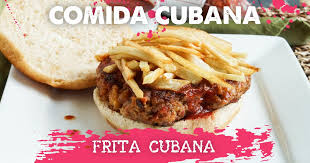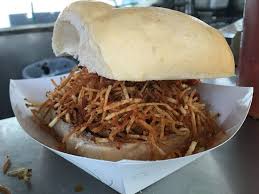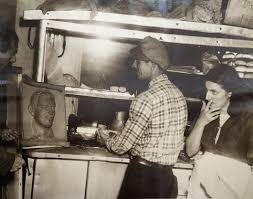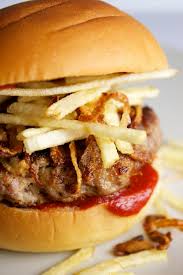 MEMORIES OF MY ISLAND: “LA FRITA CUBANA”, AN INSTITUTION ALMOST FORGOTTEN.
MEMORIES OF MY ISLAND: “LA FRITA CUBANA”, AN INSTITUTION ALMOST FORGOTTEN.
The Frita Cubana was one of the unshakable institutions of the neighborhood, as were the bodega, the coffee, and the Chinese stand, and, in another order, the quincalla. The bodeguero (also the hardware store) knew very well how to satisfy his clientele without having to resort to market research. The Chinese were famous for their fruit ice creams and their range of light foods whose origin is still unknown, since they were not Chinese or Cuban, nor did they seem to come from San Francisco, California, where all the Chinese food that was known in Cuba passed. With what they expended, the people did not eat but were filled, and all for a few pennies. Hence, both the fried and Chinese stalls were called “aid houses.” Things, however, got worse when you didn’t win even for the frit, a word that here, as a vulgarism, identified food.
Those balls of well-seasoned meat, crushed and placed between two covers of bread smeared with mustard and ketchup and with the corresponding provision of taro or fried sweet potato and cut into julienne, satisfied the appetite and gave energy for what would come later, more if It was accompanied by a soda, a guarapo or a glass of oysters. It was the best invention to kill hunger. Support of the poor that ended up imposing itself among other layers of society, as well as in their time the jerky and cod, the food of slaves, invaded and ended up taking over the table of the rich.
There were many famous fritters and fritters in Havana. The fries were in great demand from the stand located in the La Guajira winery, at 24 corners to 25, in Vedado. Also the “luxury” fries of the García Brothers, one of the points where those who attended the funeral services of the Alfredo Fernández funeral home, in Zapata between Paseo and 2, ate snacks, while other mourners wiped their tears in Los Chavales, a bar located in Paseo y 29. In the doorways of the León inn, on Diez de Octubre between Estrada Palma and Luis Estévez, in front of the now-defunct Tosca cinema, there was a woman whose fries are still in the popular imagination, Josefina Siré. On Fifth Avenue, the south sidewalk between the two roundabouts, there was a whole row of those stalls spread out before another row of seedy bars and cabarets. Although he did not work for it personally, the journalist Carlos Lechuga had his, of a high rank and select clientele, in front of the Kasalta cafeteria, at the entrance to the exclusive Miramar neighborhood.
There is no doubt that the great fritero was Sebastián Carro Seijido. Aristocratized the frit. He used only the best products. He taught his employees to work cleanly, and, above all, required them to show exquisite courtesy in their dealings with customers, and he insisted on winning over the female clientele because it was they who dragged the children away. the whole family. Sebastián Carro progressed so much that at the end of the 1950s he had the luxury of being advertised in the Golden Book of Havana society.
Sebastián Carro was one of the many Galicians who sought and found a better life on the Island.
He sold coal in Vedado, but when gas began to be imposed as a domestic fuel in the neighborhood, he realized that he had to venture into another turn. He then set up a fries stall on the ground floor of his house, in Zapata and A, but from there the decree of President Grau that prohibited sales on the portals got it. The owner of Paseo Club, a restaurant-bar in Paseo y Zapata, shook his hand by giving him, overlooking Zapata Street, a small space in his establishment.
Their fries were already famous and the influx of customers was increasing. Sebastián, despite having the help of his wife and two employees, was barely able to cope. In those establishments the bread was never used from one day to the next; it was always fresh. And in the accompaniment of the dish, Sebastián substituted the potato for the sweet potato. It was cut julienne, passed through a machine that gave it the consistency of noodles, and fried. They were then placed, together with the frit, between the two bread covers.
He then opened the El Bulevar cafeteria, on 23 between 2 and 4, and took Juan Pablo Fernández Bravo as an industrial partner; that is, someone who shares in the profits, but does not contribute capital, only their work. Juan Pablo would end his working life as captain of the restaurants at the Habana Riviera hotel. The business progressed further and Sebastián opened another cafeteria on Calle Paseo between Tercera and Quinta, which was then called Sebastián and which is now La Cocinita. When the Revolution triumphed, their plans were to expand into the Ayestarán area.
With the seizure of the business, all his efforts and dreams were left there.
The State “acquired” El Bulevar and Juan Pablo remained in charge until 1965 when he moved to the Riviera hotel. Nestor, one of Sebastián’s sons, was in charge of the Zapata y Paseo business, but he turned it into an inn. Another of his sons, Iván, ended up voluntarily delivering La Cocinita to Gastronomy. Sebastián Carro Seijido died in Havana, presumably, in the 70s.
Will Frita be part of the Cuban palate again?
Let’s hope for better times (AV).
 RECUERDOS DE MI ISLA: “LA FRITA CUBANA”, UNA INSTITUCION YA CASI OLVIDADA.
RECUERDOS DE MI ISLA: “LA FRITA CUBANA”, UNA INSTITUCION YA CASI OLVIDADA.
El puesto de fritas era una de las instituciones inconmovibles del barrio, como lo fueron la bodega, el café y el puesto de chinos y, en otro orden, la quincalla. El bodeguero (también el quincallero) sabía muy bien cómo satisfacer a su clientela sin necesidad de recurrir a estudios de mercado. Los chinos eran famosos por sus helados de frutas y su gama de alimentos ligeros cuyo origen todavía se desconoce, pues no eran chinos ni cubanos ni tampoco parecían proceder de San Francisco de California, por donde pasaba toda la comida china que se conocía en Cuba. Con lo que ellos expendían, la gente no se alimentaba, pero se llenaba, y todo por unos pocos centavos. De ahí que, tanto a los puestos de frita como a los de chinos, se les llamara «casas de socorro». La cosa, sin embargo, se ponía mala cuando no se ganaba ni para la frita, palabra que aquí, como vulgarismo, identificaba a la comida.
Aquellas bolitas de carne bien condimentada, aplastada y colocada entre dos tapas de pan untadas con mostaza y cátsup y con la provisión correspondiente de malanga o boniato frito y cortado a la juliana, satisfacía el apetito y daba bríos para lo que vendría después, más si se acompañaba de un refresco, un guarapo o una copita de ostiones. Fue el mejor de los inventos para matar el hambre. Un sostén de pobres que terminó imponiéndose entre otras capas de la sociedad, así como en su momento el tasajo y el bacalao, comida de esclavos, invadieron y terminaron por adueñarse de la mesa de los ricos.
Puestos de fritas y friteros famosos hubo muchos en La Habana. De gran demanda gozaban las fritas del puesto ubicado en la bodega La Guajira, en 24 esquina a 25, en el Vedado. También las fritas «de lujo» de los Hermanos García, uno de los puntos donde merendaban los que acudían a los velorios de la funeraria Alfredo Fernández, en Zapata entre Paseo y 2, mientras otros dolientes enjugaban sus lágrimas en Los Chavales, bar situado en Paseo y 29. En los portales de la fonda León, en Diez de Octubre entre Estrada Palma y Luis Estévez, frente al desaparecido cine Tosca, estaba una mujer cuyas fritas se mantienen aún en el imaginario popular, Josefina Siré. En la Quinta Avenida, acera sur entre las dos rotondas, había toda una hilera de esos puestos desplegados ante otra hilera de bares y cabarés de mala muerte. Aunque no lo trabajaba personalmente, el periodista Carlos Lechuga tenía el suyo, de mucho rango y clientela selecta, frente a la cafetería Kasalta, a la entrada del exclusivo reparto Miramar.
No hay duda de que el gran fritero fue Sebastián Carro Seijido. Aristocratizó la frita. Empleó solo los mejores productos. Enseñó a sus empleados a trabajar con limpieza, y, sobre todo, les exigió que, en su trato con los clientes, dieran muestras de una cortesía exquisita, y se empeñó en ganarse la clientela femenina porque era esta la que arrastraba a los niños y a toda la familia. Tanto progresó Sebastián Carro que a fines de los años 50 se daba el lujo de anunciarse en el Libro de oro de la sociedad habanera.
Sebastián Carro fue uno de aquellos tantos gallegos que buscó y encontró una vida mejor en la Isla.
Vendió carbón en el Vedado, pero cuando el gas comenzó a imponerse como combustible doméstico en la barriada, se percató de que debía incursionar en otro giro. Puso entonces un puesto de fritas en los bajos de su casa, en Zapata y A, pero de allí lo sacó el decreto del presidente Grau que prohibía la venta en los portales. El propietario de Paseo Club, restaurante-bar de Paseo y Zapata, le dio la mano al cederle, con vista a la calle Zapata, un pequeño espacio en su establecimiento.
Ya sus fritas tenían fama y la afluencia de clientes fue haciéndose cada vez mayor. Sebastián, pese a que contaba con la ayuda de su esposa y de dos empleados, apenas daba abasto. En aquellos establecimientos nunca se utilizó el pan de un día para otro; era siempre fresco. Y en el acompañamiento del plato, Sebastián sustituía la papa por el boniato. Se cortaba a la juliana, se pasaba por una máquina que le daba consistencia de fideos y se freían. Se colocaban después, junto con la frita, entre las dos tapas de pan.
Abrió entonces la cafetería El Bulevar, en 23 entre 2 y 4, y llevó a Juan Pablo Fernández Bravo como socio industrial; esto es, alguien que comparte las ganancias, pero no aporta capital, solo su trabajo. Juan Pablo concluiría su vida laboral como capitán de los restaurantes del hotel Habana Riviera. Progresó más el negocio y Sebastián inauguró otra cafetería en la calle Paseo entre Tercera y Quinta, que entonces se llamó Sebastián y que es la actual La Cocinita. Cuando triunfó la Revolución, sus planes eran los de expandirse hacia la zona de Ayestarán.
Con la incautación del negocio, alli quedaron todos sus esfuerzos y sueños.
El Estado “adquirió” El Bulevar y Juan Pablo se mantuvo como encargado hasta 1965, cuando pasó al hotel Riviera. Néstor, uno de los hijos de Sebastián, quedó al frente del negocio de Zapata y Paseo, pero lo convirtió en una fonda. Otro de sus hijos, Iván, terminó entregando voluntariamente La Cocinita a Gastronomía. Sebastián Carro Seijido falleció en La Habana, presumiblemente, en los años 70.
Volverá la Frita a ser parte del paladar cubano?
Esperemos tiempos mejores (AV).
Agencies/ RHC/ Ciro Bianchi/ Extractos/ Excerpts/ Internet Photos/ Arnoldo Varona/ www.TheCubanHistory.com
THE CUBAN HISTORY, HOLLYWOOD.














